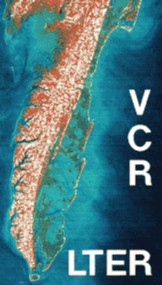
\ |

Deirdre A. Joy and D. R. Young
Department of Biology
|

\ |

Deirdre A. Joy and D. R. Young
Department of Biology
|
Positive interactions between Juniperus virginianaand woody seedlings may influence trends in primary succession along the Atlantic Coast. The effect of J. virginiana on the distribution of woody seedlings may be either passive, through the non-random distribution of fleshy seeds by perching birds, or active, through increased seedling survival due to J. virginiana initiated alterations in microclimate and edaphic factors. Field observations on a Virginia barrier island suggest that woody species richness is greater beneath J. virginiana canopies than in nearby exposed sites. Experimental planting of Sassafras albidum and Prunus serotina seedlings resulted in lower seedling mortality near (0.3 m) J. virginiana compared with seedlings in the far treatment (3.0 m). Photosynthetically active radiation was reduced below J. virginiana, and both soil and air temperature fluctuations were moderated during the growing season. In addition, soil pH and organic matter content were higher under J. virginiana than in exposed sites; however, soil chlorides were also higher under J. virginiana. Seedbank analysis suggests that fleshy fruited seeds are more abundant beneath J. virginiana than in nearby exposed sites, indicating that J. virginiana may be utilized by passerine birds. Juniperus virginiana may act as a nurse plant for woody seedlings in the harsh environments along the Atlantic coast.